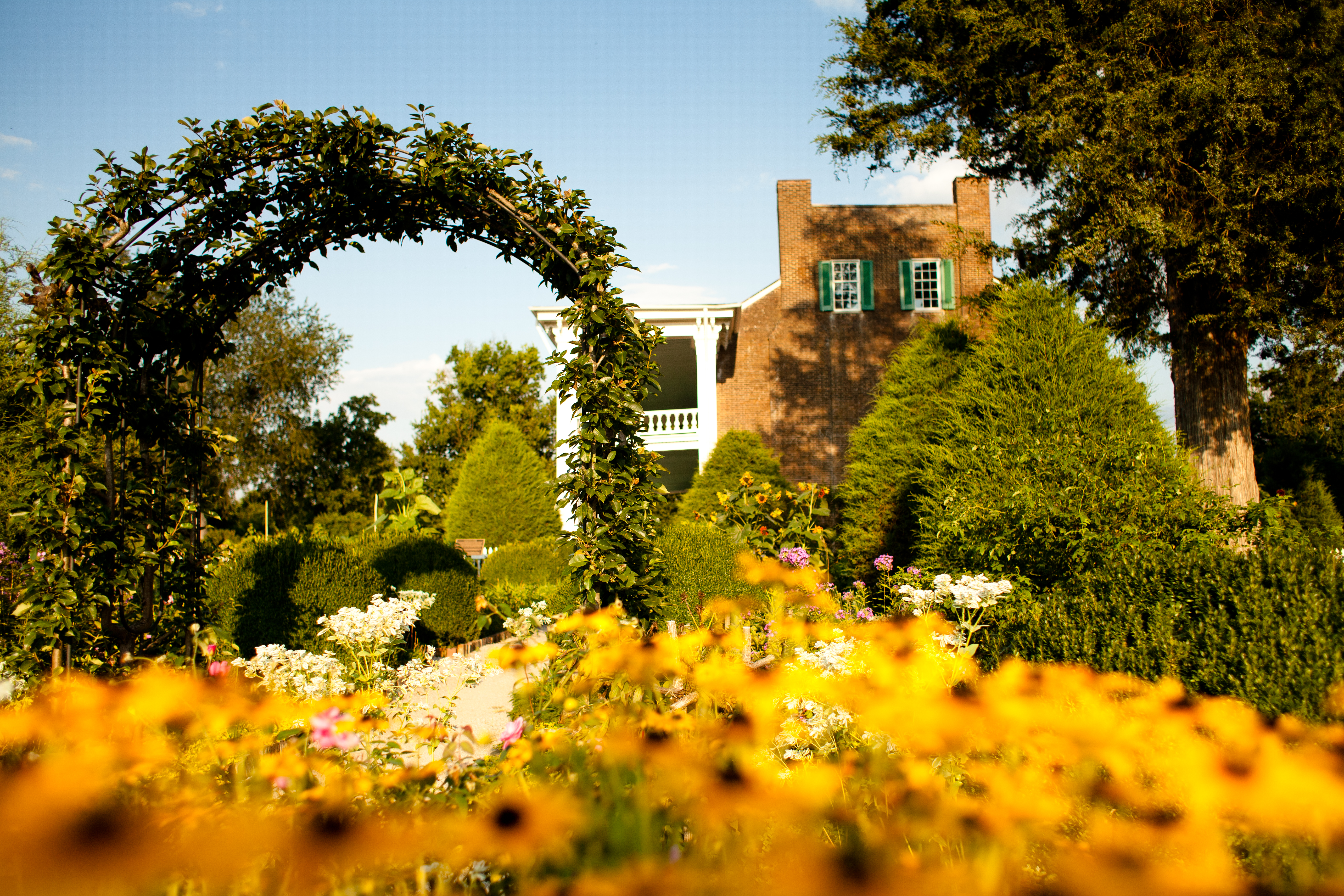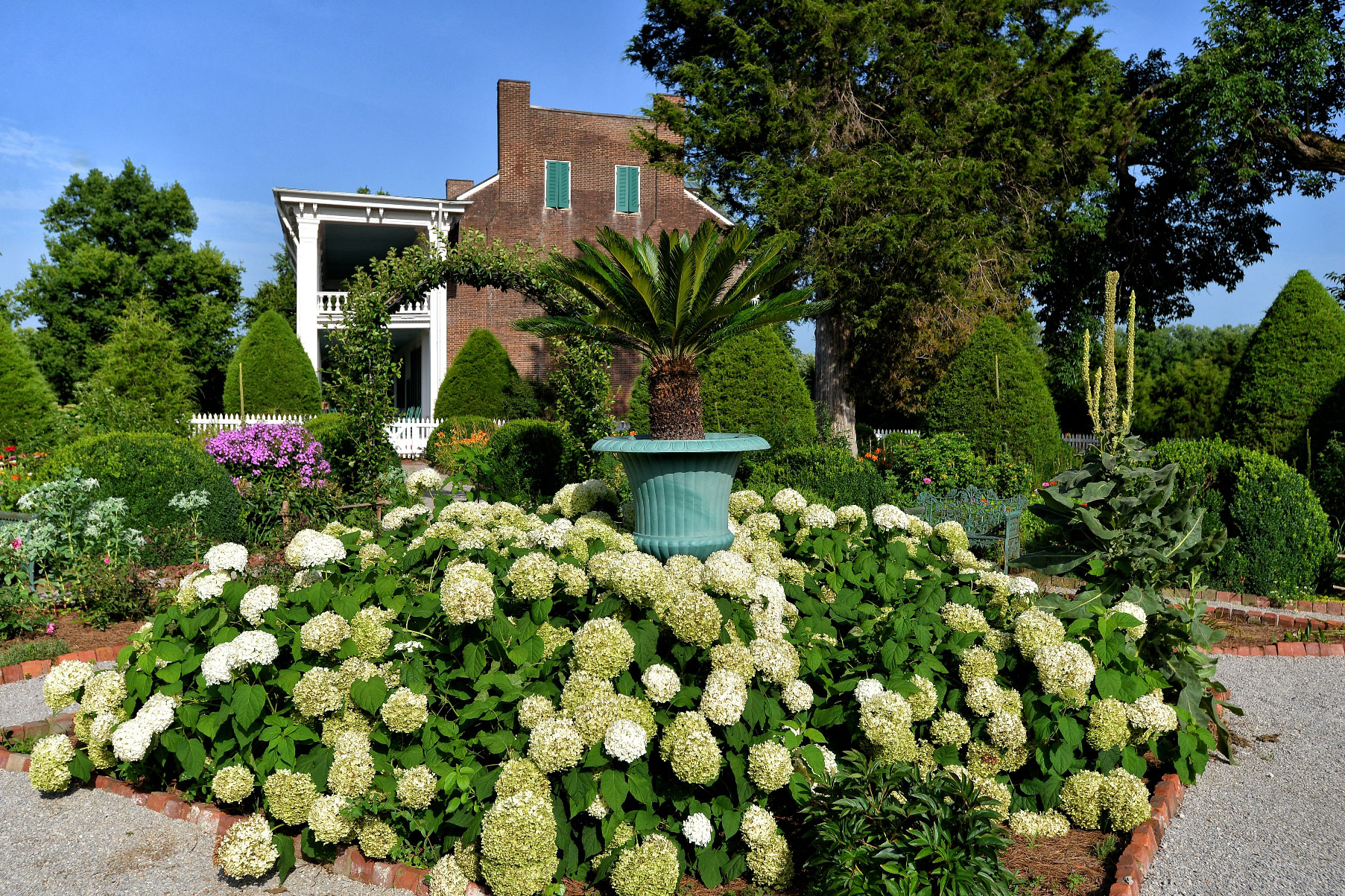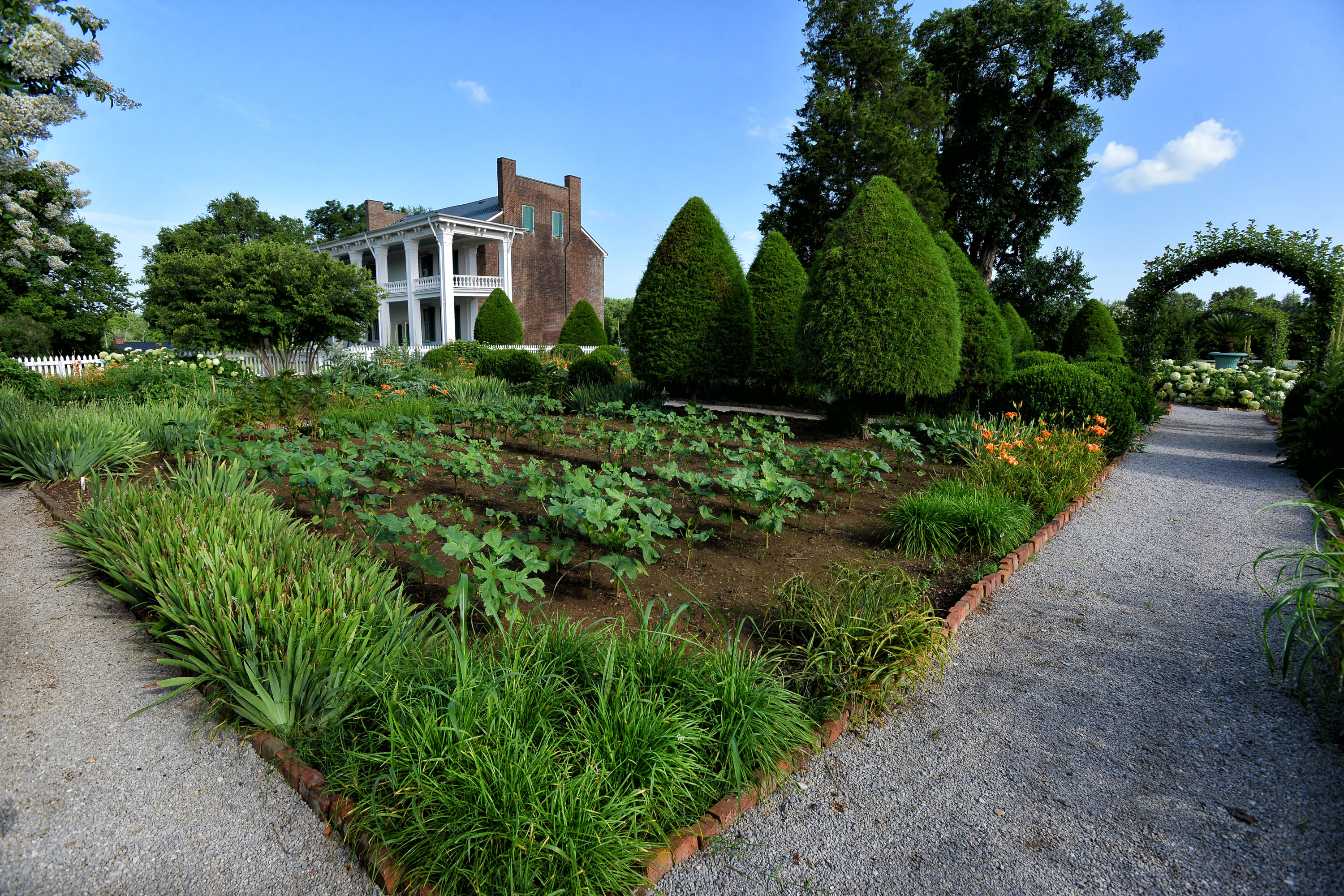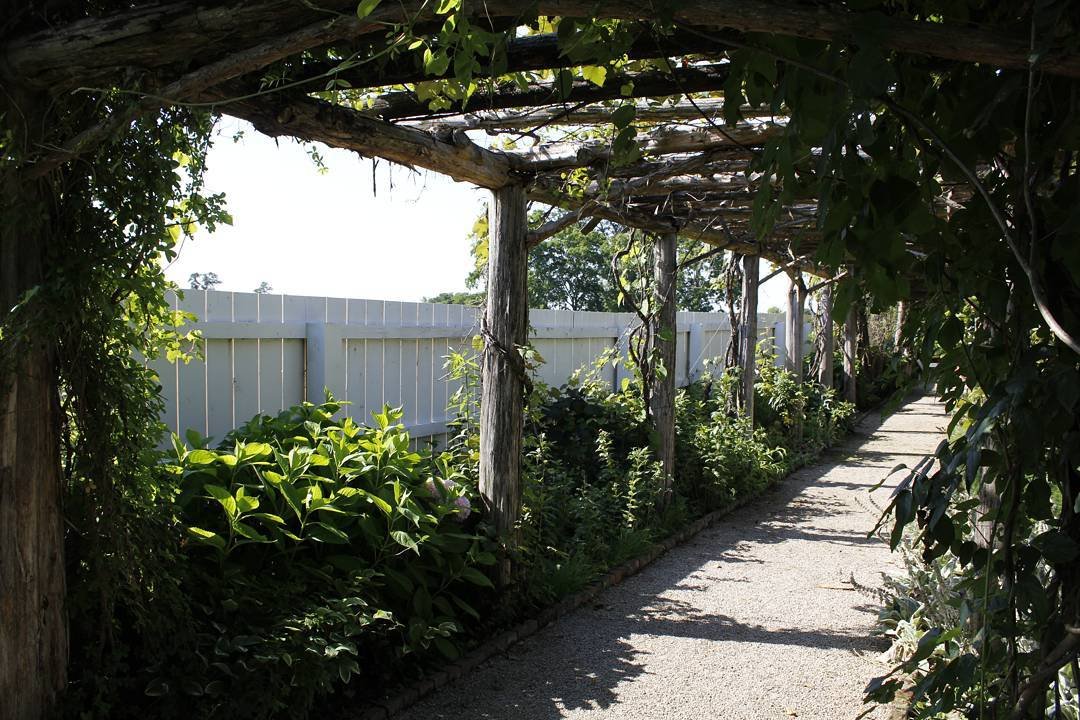
Justin Stelter describes the garden at
Carnton as a long love affair. He tenderly cultivates the plants, appreciates the fruits of his labors, and above all, is always seeking to better understand the garden as a living, breathing entity.
He has been meticulously restoring the property grounds and gardens for 17 years. And, this diamond has taken some polishing.
To the right of Carnton’s back porch—that’s what visitors see when they first come onto the property—is a square acre of kitchen and ornamental garden, with rose quadrants, eight perimeter vegetable beds, sweet-smelling Hostas, and an arbor featuring 1849 and 1852’s grape of the year: The Concord.
While he now talks about the garden with near reverence, the seasoned gardener didn’t study horticulture in school. In fact, at first, he didn’t even know he was attending a job interview at Carnton.
He walked out on a hot morning—mid-nineties, as he remembers it—to five men sitting in the middle of the garden pulling weeds.
He didn’t know anything about historic gardening at the time, but there was one thing, being in the landscaping business, that he did know—they weren’t weeding correctly.
“If you’re sitting down, you can only reach the area right around you. You’re not going to get anything done,” he told the men. “You can only get the garden weeded if you’re standing up.”
They asked him for a report on what he would do with the garden. He handed in a two-page, double-spaced paper. “I used the word ‘weed’ 40 or 50 times to get my point across,” he says.
He started as the head gardener at Carnton back in 2003, now holding the title of Director of Grounds & Gardens for the
Battle of Franklin Trust. “It was sheer luck and accidental timing.”
The history behind the Civil War-era garden goes back over 150 years. And, to appreciate the garden, Justin says, we must understand the history.

Bucking Around Carnton
In 1786, James McGavock—of the wealthy Virginia McGavocks—purchased a military warrant for a section (640 acres) of land in Franklin. After buying an adjacent section and a few other plots, he ended up with nearly 1400 acres of prime, fertile farmland.
His son, Randall, came to Middle Tennessee to be the caretaker. By 1826, Randall built what now stands as the Carnton mansion.
In 1843, Randall died and left Carnton to his son, John McGavock. John assumed the leadership role of his father’s land and was joined by his wife, Carrie McGavock. John decided to make some changes.
An old letter says, “John is bucking around Carnton again. He has enlarged the front lawn, he has built a fine Portico, he’s built a serpentine brick walk and he has removed the garden.”
In the 19th century, this prefix “re-” signified “do again.” In 1847, John moved what was likely a small garden to the acre it currently occupies next to the mansion.
Nearly twenty years later, Confederate troops moved toward downtown Franklin in what would be one of the most significant historical events in Tennessee’s history: The
Battle of Franklin on November 30, 1864.
The following morning, Carnton was used as a field hospital for over 300 dead, dying, or wounded soldiers.
After the battle, the troops moved on. Burials were quick and poorly executed—some men were buried in ditches and fields. As farmers began to plow for the following season, they found bodies. In 1867, to “spare souls from the plowshare,” as Justin says, John McGavock put an advertisement in the local paper asking for contributions to help give “our boys, those who gave so much to us” a final resting place.
He donated two acres of rich, tillable Carnton land—a mark of the respect he wanted to pay to the dead—and raised money for a cemetery.
Nearly 1500 men were reburied at Carnton, creating the largest private military cemetery in the country. By 1869, a cast-iron fence was put in place surrounding the grounds and marked the end of the construction.
In the 1910s, the property went into decline. The South was being rebuilt. Labor was no longer free. The property was sold out of the McGavock lineage and rented to tenant farmers.
Carnton grew wild.
Drawing the Map
In 1978, a group of citizens formed the Carnton Association, with the sole intent to protect and preserve the land’s history. The home was in ruins; the grounds were overgrown.
Enter Robert Hicks—a New York Times best-selling author and a passionate preservationist who played a major role in Carnton’s restoration. He tried to figure out what the grounds may have looked like, doing research for any receipts, records, drawings, or notes.
There wasn’t much to be found. Through the generosity of a local donor, the Association hired landscape historians and consultants.
Robert called Peter Hatch, the Director of Gardens & Grounds for Monticello, and an authority on early great American gardening. Peter recommended Jerry Doyle, a consultant in New York who had done a lot of research on Middle Tennessee gardens.
On the day he was supposed to meet Jerry, a November morning, Robert was a few minutes late. As Justin tells the story—Robert came barreling down the old driveway.
It’s cold; there’s frost on the ground. Robert jumped out of his truck to apologize for his tardiness and saw Jerry sitting cross-legged in the middle of the garden. Jerry held up a finger to silence him.
Robert stood there for what felt like 30 minutes. Jerry pointed at the house. He said, “Do you see it?” Robert’s heart sank. Did he hire a kook?
Jerry was actually pointing at the ground in front of him. As the sun crested over the roofline and the rays beat down on the overgrown ground, Robert finally saw it.
There were spaces where the light penetrates the ground. The areas where the frost melts first mark where pathways once were.
“Jerry was the right man for the job,” Justin says. “He was smart enough to read the landscape. Logically, it makes sense; the garden sits in an axial relationship with the back porch, which was the perfect place for a beautiful garden.”
An archeologist confirmed the original pathways, the Cedars, and an arbor in the garden. A map of John McGavock’s garden begins to take shape, with perimeters and pathways. Trees were identified through soil samples, and fencing was seen in photographs.
In the mid-90s, the garden was recreated. But, by 2003, it was lost again. “Just because you build something doesn’t mean you can go,” Justin says. The garden wasn’t maintained properly.
When he came in the summer of 2003, on Robert’s recommendation, the weeds were chest-high. “It looked like a jungle.”

Planting Projects
Justin started simply—weeding. Just as he told those men on his first blind date with the garden: “We don’t need to make this complicated.” He still claims “keeping the garden weed-free” as his unofficial job description.
“If you don’t maintain a garden, no one really wants to see it or understand it,” Justin says. He took it upon himself to recreate Carnton’s garden as accurately as he could.
His interpretation was through two key dates: 1847 when John McGavock made stylistic alterations to the property and 1869 when the cemetery was completed.
What would John McGavock have done? Carnton’s farm had been prosperous and innovative.
John McGavock was an avant-garde Southern gentleman who tried new things. He wanted to tame nature. His garden was so significant that he had named it in his will.
Justin, a researcher, surrounded himself with “the best gardens, the best books about gardens, and the best people about gardens.” One of his passions is looking at history through the lens of gardening.
He challenged himself to find the answers, because, as he says, “the garden is worthy.” He dug into those mid-1800s techniques and educated himself on what native Tennessee plants may have grown in the garden.
He believes the garden was patterned on the designs of landscape architect Andrew Jackson Downing. Overlay two of Downing’s designs and it makes the Carnton garden.
Justin paints a picture of texture and shape: “We have round boxwoods and ornamentation to create punctuation to guide you through. They stay low, not to overwhelm you. We have Cedars that mimic Italian Cyprus in a conical structure that brings the garden a little bit of height and texture change. The boxwood is tighter, darker, and shinier. The Cedar is wispy and coarse, in a different green.”

Justin, his team, and a slew of volunteers implemented five planting projects to get the garden off the ground with the goal of educating the public.
The first was roses. There are four quadrants of roses, all varieties that could have been found back when John McGavock was planting: Rosa Rugosa Alba, Madame Plantier, and even Le Vesuve— the more fragrant, disease-resistant, great, great grandmother of the popular Knockout Rose.
The second project was daffodils, the third peonies, the fourth Hostas, and the fifth an intricate Kiefer pear espalier designed by Peter Thevenot. An extravagant espalier would have shown off the family’s wealth.
While there is some documentation around the plants that have been used—all must have been available or growing in Middle Tennessee prior to 1869—what we don’t know, Justin explains, is where every single plant was.
His team looked at plant catalogs, online articles, letters, and a lot of books. “Anything in Philadelphia or New York in the 1830s and 40s could be in Tennessee within six months,” Justin says. “Do we know the McGavocks planted Concord grapes on their arbor? No, but it makes sense that they might have—it was the most popular plant. They wanted grapes. They had an arbor.”

There are a few exceptions to the time period, Justin reveals. There were no sprinkler systems in Franklin back then, although one could guess that the flashy John McGavock would have put his name at the top of the list for installation.
“Not everything can be black or white,” Justin says. “We’ve hybridized plants and improved them.” Native crepe myrtles around that time period were devastated by powdery mildew. New varieties, like the Natchez, were hybridized. “Is this technically a 1970s hybrid plant I’m allowing in my garden? Yes. But, its parents aren’t some new plant.”
A letter from one of Carrie McGavock’s cousins resulted in a sweet addition to the garden: strawberries.
It reads, “Carrie when you come to our party, can you please bring one of your famous strawberry pies?” She may have gotten a pie at Publix, Justin joked—or maybe she grew strawberries.
“There is a common-sense portion to gardening,” he says. When they couldn’t find the native honeysuckle plant—“We couldn’t find the doggone thing anywhere!”—they eventually located it in the backyard of a little lady in downtown Franklin.
The key to protecting Southern gardens is to study and restore them if need be, Justin says. But, that’s not always hands-on work. His goal, rather, is to educate.
“We want to be the impetus to help people restore the gardens. We want to share our knowledge and give advice.” It’s not so much about preserving species; it’s about preserving old techniques.
“The garden will always evolve. There are always things that I can learn and everyone around me can learn. We can all learn together. We can share information and extend our working knowledge of this garden so that it doesn’t become stagnant.”
Carnton partners with The Giving Garden, sponsored by the Methodist Church, to share their bounty with those in need. “It’s a win-win-win,” Justin says. “Carnton wins because we have volunteers come and help us. The community wins because the garden looks more beautiful because of their efforts. And, the master gardeners win because they get some training and volunteer hours.”

The Right Man for the Job
Some people call Justin an old spirit, which he can’t deny. He likes old things—things with patina. He knew he didn’t want to work from nine to five using his degree in economics when he could work outside with his hands in the dirt.
He was naïve when he first looked at the garden. “I thought it was going to be easy,” he says. “I was a landscaper, not a historic gardener.” He didn’t know what he was dealing with; he saw the garden as a beautiful space that needed some help.
“Part of that naïve confidence is what drove me to dig into the subject matter. I had nowhere to go but up. It was back-breaking, hot, dirty work—but for me, it was second nature.”
He continues to learn just as much as he teaches. Recently, Carnton had ground-penetrating radar in the cemetery, discovering 10 more unmarked bodies.
The Battle of Franklin Trust erected a monument honoring the men, women, and children of Africa that were enslaved at Carnton. The large stone marker includes “Enslaved in life / Freed in death” and “Their souls rise up to greet a new morning.”
Justin points out that the original path into the cemetery resulted in people accidentally walking on top of a headstone. “It comes back to not paying attention. We have to educate ourselves. We want everyone to be aware that this is sacred ground.”
He attributes his success to the people around him who have built Carnton up—especially the volunteers.
“There are wonderful people over the years who have guided, trained, and provided all sorts of assistance. At times, we put ourselves in over our heads. When that happens, look around you. There are always people willing to help. Gardening is a process—a dynamic thing that we can all learn from. Part of that process is learning and creating with others.”
Justin’s favorite season in the garden is the spring, for the renewal and new growth. He also loves the fall, which represents the harvest—the great reward for all the effort they’ve sown. The fall symbolically represents a time of rest and reflection.
While his first several years on the property were a blurry whirlwind, he’s wiser now. As nature slows down, he slows down. “Nature is so powerful that we should really try to listen, understand, and work with it instead of against it. Just when you think you’ve got it,” he says, “you will always be beaten by nature. Nature will always win.”
His final plea? Don’t overlook the history in your own backyard—it’s an essential part of the fabric of Franklin.
“We all want to go out on adventures and experience new things. Don’t forget to visit the important sites in your own community. It’s for your support, but it’s also for you. We can build stronger communities by supporting those around us. These sites, like Carnton, are important—and we need to show them that they’re important.”
Learn more about Carnton and plan your visit to this rich, historical site here.

